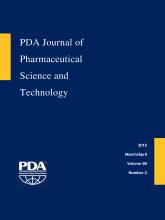Research ArticleResearch
Utilization of the Tyndall Effect for Enhanced Visual Detection of Particles in Compatibility Testing of Intravenous Fluids: Validity and Reliability
Vigdis Staven, Marit Waaseth, Siri Wang, Ingrid Grønlie and Ingunn Tho
PDA Journal of Pharmaceutical Science and Technology March 2015, 69 (2) 270-283; DOI: https://doi.org/10.5731/pdajpst.2015.01020
Vigdis Staven
1Hospital Pharmacy of North Norway Trust, Tromsø, Norway;
2Drug Transport and Delivery Research Group, Department of Pharmacy, Faculty of Health Sciences, UiT The Arctic University of Norway, Tromsø, Norway;
Marit Waaseth
3Microbiology, Molecular and Pharmaco-Epidemiology Research Group, Department of Pharmacy, Faculty of Health Sciences, UiT The Arctic University of Norway, Tromsø, Norway;
Siri Wang
4Department for Medicinal Product Assessment, Norwegian Medicines Agency, Kalbakken, Oslo, Norway;
Ingrid Grønlie
5Norwegian Medicines for Children Network, Bergen, Norway;
6Hospital Pharmacy at Haukeland University Hospital, Bergen, Norway; and
Ingunn Tho
2Drug Transport and Delivery Research Group, Department of Pharmacy, Faculty of Health Sciences, UiT The Arctic University of Norway, Tromsø, Norway;
7PharmaLuxLab, School of Pharmacy, Faculty of Mathematics and Natural Sciences, University of Oslo, Blindern, Oslo, Norway

References
- 1.↵
- Hill S. E.,
- Heldman L. S.,
- Goo E. D.,
- Whippo P. E.,
- Perkinson J. C.
- 2.↵
- Doessegger L.,
- Mahler H-C.,
- Szczesny P.,
- Rockstroh H.,
- Kallmeyer G.,
- Langenkamp A.,
- Herrmann J.,
- Famulare J.
- 3.↵
- Walpot H.,
- Franke R. P.,
- Burchard W. G.,
- Agternkamp C.,
- Müller F.,
- Mittermayer C.,
- Klaff G.
- 4.↵
- Puntis J. W. L.,
- Wilkins K. M.,
- Ball P. A.,
- Rushton D. I.,
- Booth I. W.
- 5.↵
- Hellinger A.,
- Piotrowski J.,
- Konerding M. A.,
- Burchard W. G.,
- Doetsch N.,
- Peitgen K.,
- Erhard J.,
- Reidemeister J. C.
- 6.↵
- Jack T.,
- Brent B. E.,
- Boehne M.,
- Müller M.,
- Sewald K.,
- Braun A.,
- Wessel A.,
- Sasse M.
- 7.↵
- Sherwood L.
- 8.↵
- Parikh M. J.,
- Dumas G.,
- Silvestri A.,
- Bistrian B. R.,
- Driscoll D. F.
- 9.↵
- Lehr H. A.,
- Brunner J.,
- Rangoonwala R.,
- Kirkpatrick C. J.
- 10.↵
- Ball P. A.
- 11.↵
European Pharmacopoeia. 2.9.20. Particulate Contamination: Visible Particles. In European Pharmacopoeia, 8th ed.; Supplement 8.0., 2014.
- 12.↵
United States Pharmacopoeia. <1> Injections. In USP 36–NF 31.
- 13.↵
Japanese Pharmacopoeia. 6.06. Foreign Insoluble Matter Test for Injections. In Japanese Pharmacopoeia, 16th ed.
- 14.↵
European Pharmacopoeia. 2.9.19. Particulate Contamination: Sub-visible Particles. In European Pharmacopoeia, 8th ed.; Supplement 8.0, 2014.
- 15.↵
United States Pharmacopoeia. <788> Particulate Matter in Injections; In USP 36-NF 31.
- 16.↵
Japanese Pharmacopoeia. 6.07. Insoluble Particulate Matter Test for Injections. In Japanese Pharmacopoeia, 16th ed.
- 17.↵
- Tran T.,
- Kupiec T. C.,
- Trissel L. A.
- 18.↵
- Mahler H.-C.,
- Jiskoot W.
- Smulders R.,
- Vos H.,
- Mahler H.-C.
- 19.↵
- Newton D. W.
- 20.↵
- Newton D. W.
- 21.↵
- Newton D. W.,
- Driscoll D. F.
- 22.↵
- Veggeland T.,
- Brandl M.
- 23.↵
- Minton A. R.,
- Barnett M. I.,
- Cosslett A. G.
- 24.↵
- Trissel L. A.,
- Gilbert D. L.,
- Martinez J. F.,
- Baker M. B.,
- Walter W. V.,
- Mirtallo J. M.
- 25.↵
- Trissel L. A.,
- Gilbert D. L.,
- Martinez J. F.,
- Baker M. B.,
- Walter W. V.,
- Mirtallo J. M.
- 26.↵
- Husson E.,
- Crauste-Manciet S.,
- Hadj-Salah E.,
- Seguier J.,
- Brossard D.
- 27.↵
- Bouchoud L.,
- Fonzo-Christe C.,
- Klingmüller M.,
- Bonnabry P.
- 28.↵
- Garvan J. M.,
- Gunner B. W.
- 29.↵
- Trissel L. A.,
- Martinez J. F.
- 30.↵
- Singh B. N.,
- Dedhiya M. G.,
- DiNunzio J.,
- Chan P.,
- Kupiec T. C.,
- Trissel L. A.,
- Laudano J. B.
- 31.↵
- Knapp J. Z.,
- Kushner H. K.
- 32.↵
- Faesen A. C.
- 33.↵
- Borchert S. J.,
- Maxwell R. J.,
- Davison R. L.,
- Aldrich D. S.
- 34.↵
- Sadeghipour F.,
- Bugmann A.,
- Herrera V.,
- Bonnabry P.
- 35.↵
- Knapp J. Z.
- 36.↵
- Gerstman B. B.
- 37.↵
- Akobeng A. K.
- 38.↵
- Egger M.,
- Smith G. D.,
- Altman D. G.
- Deeks J. J.
- 39.↵
- Fleiss J. L.
- 40.↵
- Gwet K. L.
- 41.↵
- Landis J. R.,
- Koch G. G.
- 42.↵
- Trissel L. A.,
- Bready B. B.
- 43.↵
European Pharmacopoeia. 2.2.1. Clarity and Degree of Opalescence of Liquids. In European Pharmacopoeia, 8th ed.; Supplement 8.0, 2014.
- 44.↵
- Jaeschke R.,
- Guyatt G. H.,
- Sackett D. L.
- 45.↵
Filter Manufacturers Council. Technical Service Bulletin 89-5. The Micron Rating for Media in Fluid Filters. www.aftermarketsuppliers.org/Councils/Filter-Manufacturers-Council/TSBs-2/English/89-5R3.pdf (accessed Mar 10, 2014).
- 46.↵
- Vessey I.,
- Kendall C. E.
- 47.↵
- Migaki E. A.,
- Melhart B. J.,
- Dewar C. J.,
- Huston R. K.
- 48.↵
- Driscoll D. F.,
- Newton D. W.,
- Bistrian B. R.
In This Issue
PDA Journal of Pharmaceutical Science and Technology
Vol. 69, Issue 2
March/April 2015
Utilization of the Tyndall Effect for Enhanced Visual Detection of Particles in Compatibility Testing of Intravenous Fluids: Validity and Reliability
Vigdis Staven, Marit Waaseth, Siri Wang, Ingrid Grønlie, Ingunn Tho
PDA Journal of Pharmaceutical Science and Technology Mar 2015, 69 (2) 270-283; DOI: 10.5731/pdajpst.2015.01020
Jump to section
Related Articles
- No related articles found.





